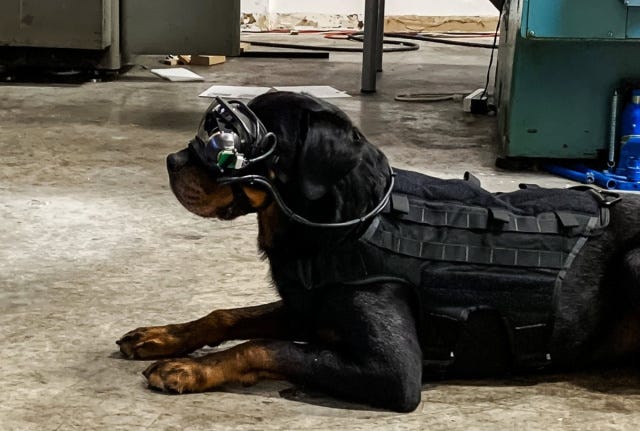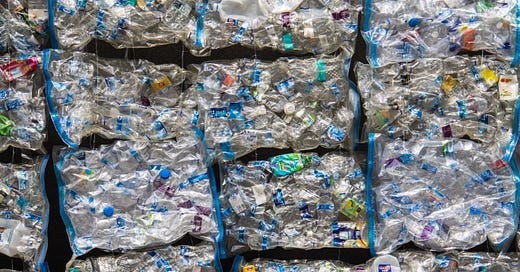Welcome to Thursday Things. This week we run with scissors, gear up dogs, and find a black hole the last place you’d think to look. Let’s go!
Plastic makes perfect. Photo by Nick Fewings on Unsplash
Scientists win historic Nobel chemistry prize for 'genetic scissors'
Two scientists have been awarded the 2020 Nobel Prize in Chemistry for developing the tools to edit DNA.
Emmanuelle Charpentier and Jennifer Doudna are the first two women to share the prize, which honours their work on the technology of genome editing.
Their discovery, known as Crispr-Cas9 "genetic scissors", is a way of making specific and precise changes to the DNA contained in living cells.
They will split the prize money of 10 million krona (£861,200; $1,110,400).
Biological chemist Pernilla Wittung-Stafshede, commented: "The ability to cut DNA where you want has revolutionised the life sciences."
The Nobel Prize is not the sort of quirky, possibly overlooked story we usually go for here at Thursday Things, but I’m excited about this one. I’ve linked stories about Crispr technology before. In a previous incarnation, I was a speechwriter for the head of the main biotechnology industry trade association. Many of the speeches I wrote were about the benefits of biotechnology for treating and curing diseases — but too often I had to write about things that were “coming soon”. As in “someday soon we may be able to treat such and such condition with promising new therapeutics, etc.”
The breakthrough discoveries of Emmanuelle Charpentier and Jennifer Doudna (and, to be fair, a rival research team at MIT and Harvard's Broad Institute) makes many of those “someday” treatments possible now, as well as opening up new possibilities we hadn’t even considered before:
Since the two scientists discovered the Crispr-Cas9 genetic scissors, their use has exploded. The tool has contributed to many important discoveries in basic research; and, in medicine, clinical trials of new cancer therapies are underway.
The technology also holds the promise of being able to treat or even cure inherited diseases. It is currently being investigated for its potential to treat sickle cell anaemia, a blood disorder that affects millions of people worldwide.
I left that biotech industry job around the time soon after their breakthrough paper on Crispr-Cas9 was published. If I were still writing such speeches I’d be able to put a lot more lifesaving benefits of biotech in the present tense. Congratulations to Doctors Charpentier and Doudna!
We’ll stick with a science theme. And when I want in depth, credible, no nonsense coverage of important developments in science, there is only one place to go: the Daily Star! 'There is a black hole at the centre of EARTH' NASA insider in claim about planet's core
But former NASA scientist Louise Riofrio believes there may be one far closer to home.
“While people have looked for black holes in space, there could be a black hole in the last place they would think – beneath their feet inside the Earth,” she told Blake Cousins, of YouTube channel thirdphaseofmoon.
“It would be a tiny thing – almost the grain of sound but as heavy as the moon.
“Billions of years ago, the Earth would have revolved around this black hole – that black hole is responsible for generating our heat.
“That causes volcanoes and earthquakes but also our islands to form.
“The black hole would also generate the magnetic field that protects us from space.
“Our planet might not exist without black holes.”
One wonders why she is a former NASA scientist. Anyway, this is why you come to Thursday Things, so there you go - science delivered!
Recycling — sham or hoax? As City Budgets Shrink, It’s Time to Rethink Recycling Programs. I like the idea of recycling. I’m very much one to reuse and repurpose things to get the most possible value out of things I buy, and certainly if objects I no longer need, or trash I’m throwing out can be used as a source for raw materials, that sounds great! But, alas, the key word is here is sounds great. The reality is somewhat short of the sales pitch:
When recycling programs became common three decades ago, they were sold to taxpayers as a win-win, financially and environmentally: Cities expected to reap budget savings through the sale of recyclable materials, and conscientious taxpayers expected to reduce ecological destruction. Instead, the painful reality for enthusiastic, dutiful recyclers is that most recycling programs don’t make much environmental sense. Often, they don’t make economic sense, either.
The chief buyers of American recyclable materials used to be Asian countries, chiefly China, where wages were low enough to justify labor-intensive recycling operations. But as part of Beijing’s “National Sword” policy, China began banning imports of “foreign trash” in 2017. Other Asian countries also began imposing their own restrictions. Meanwhile, reduced demand sent prices tumbling. The market price for mixed paper, for example, droppedfrom $160 to $3 per ton from March 2017 to March 2018.
As a result, cities that once collected some revenue for bales of recyclables (though typically not enough to cover the extra costs that recycling introduces into a municipal budget) must now pay to get rid of them. In many cases, they simply send them to landfills
It might worth inquiring into the economics and true benefits, if any, of your local recycling program. As well as the costs. Too often with feel-good initiatives like “recycling to save the planet!” no one wants to talk about the costs:
Meanwhile, recycling has its own environmental drawbacks, like the burning of fossil fuels in the trucks and ships carrying recyclables (especially on international trips). Many western recyclables have ended up polluting the seas, because these materials were sent to Asian, Latin American, and African waste-processing facilities that allowed plastics to leak into rivers—a phenomenon that is responsible for virtually all the consumer plastics that wind up in the oceans.
Cyberdogs! The US Army is putting AR goggles on military dogs to better guide them.

“Do they know I’m playing Squirrel Hunt?” Source: Command Sight
Why is this not already an animated series? Cyber Dog Squad!
Dogs wearing goggles are the cutest — just look at the photo above. In this particular dog’s case, though, the goggles are more than just an accessory: They’re an augmented reality device designed specifically for use by canine members of the military.
You have to wonder if they will spin off a civilian version, with entertaining VR games for your dog like Squirrel Hunt, Ball Chase, Sofa Shred, and Fetch?
Thank you for reading Thursday Things! I’ll see you next Thursday



